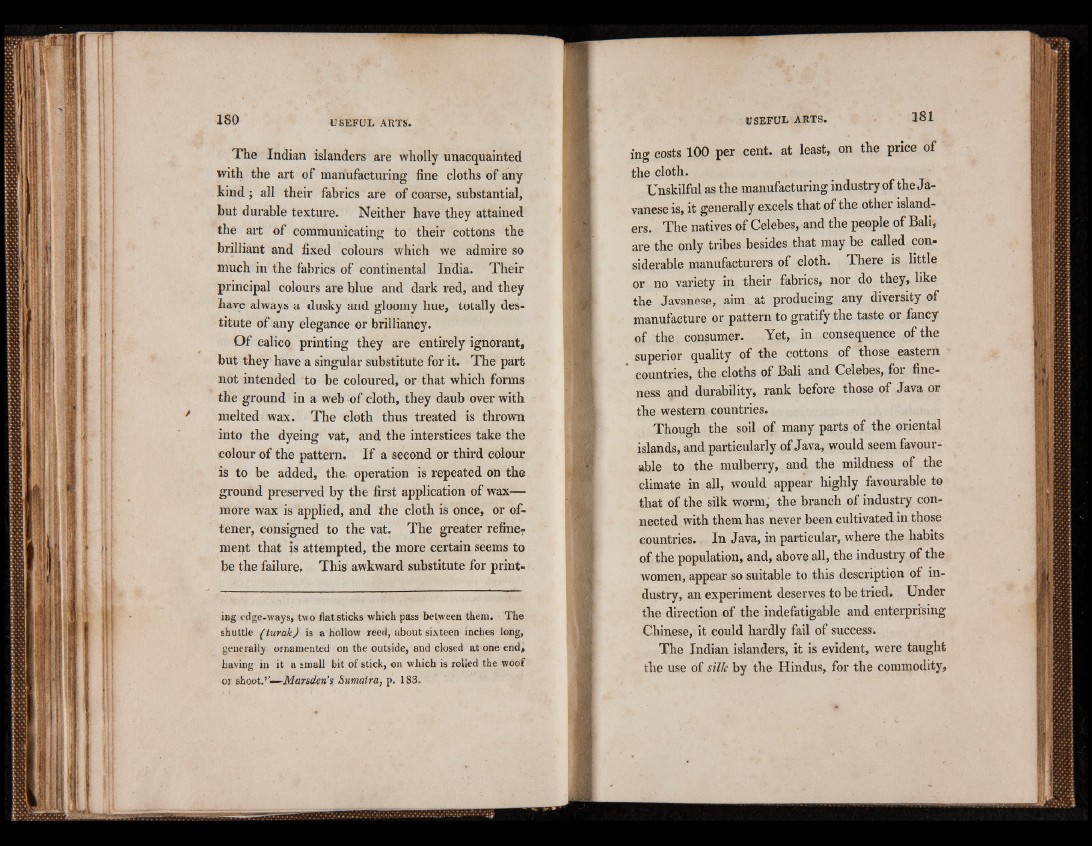
The Indian islanders are wholly unacquainted
with the art of manufacturing fine cloths of any
kind j all their fabrics are of coarse, substantial,
but durable texture. Neither have they attained
the art of communicating to their cottons the
brilliant and fixed colours which we admire so
much in the fabrics of continental India. Their
principal colours are blue and dark red, and they
have always a dusky and gloomy hue, totally destitute
of any elegance or brilliancy.
Of calico printing they are entirely ignorant,
but they have a singular substitute for it. The part
not intended to be coloured, or that which forms
the ground in a web of cloth, they daub over with
melted wax. The cloth thus treated is thrown
into the dyeing vat, and the interstices take the
colour of the pattern. If a second or third colour
is to be added, the. operation is repeated on the
ground preserved by the first application of w a x -
more wax is applied, and the cloth is once, or of-
tener, consigned to the vat. The greater refinement
that is attempted, the more certain seems to
be the failure, This awkward substitute for printing
edge-ways, two flat sticks which pass between them. The
shuttle ( turafc) is a hollow reed, about sixteen inches long,
generally ornamented on the outside, and closed at one end,
having in it a small bit of stick, on which is rolled the woof
01 shoot.’’—Marsden’s Sumatra, p. 183.
ins costs 100 per cent, at least, on the price of
the cloth.
Unskilful as the manufacturing industry of the Javanese
is, it generally excels that of the other islanders.
The natives of Celebes, and the people of Bali,
are the only tribes besides that may be called considerable
manufacturers of cloth. There is little
or no variety in their fabrics, nor do they, like
the Javanese, aim at producing any diversity of
manufacture or pattern to gratify the taste or fancy
of the consumer. Yet, in consequence of the
superior quality of the cottons of those eastern
countries, the cloths of Bali and Celebes, for fineness
and durability, rank before those of Java or
the western countries.
Though the soil of many parts of the oriental
islands, and particularly of Java, would seem favourable
to the mulberry, and the mildness of the
climate in all, would appear highly favourable to
that of the silk worm, the branch of industry connected
with them has never been cultivated in those
countries. In Java, in particular, where the habits
of the population, and, above all, the industry of the
women, appear so suitable to this description of industry,
an experiment deserves to be tried. Under
the direction of the indefatigable and enterprising
Chinese, it could hardly fail of success^
The Indian islanders, it is evident, were taught
the use of silk by the Hindus, for the commodity,